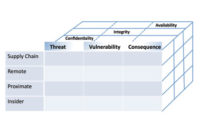Why Cyber is a Business Risk Issue

In a public company, would IT staffers be concerned with the recent HBGary research that cyber attacks can affect investor decisions and stock prices? Probably not. But the C-suite has the unique ability to understand business risk, and once you understand that your market cap is dropping due to cyber crime exposure and risk, you understand you have a business problem. Here are the facts:
• 67% of investors are likely to research whether a company has been fined or sanctioned for previous cybersecurity incidents;
• 69% are unlikely to invest in a company with a history of data breaches;
• 78% are unlikely to invest in a company with a history of one or more cyber attacks;
• 71% would be interested in reviewing a company’s cybersecurity history if it was included in regulatory filings; and
• 66% of investors are more concerned about a company’s reaction to a cyber attack than the attack itself.
Investors are twice as concerned about customer data (57 percent) versus theft of intellectual property (29 percent), the survey found. “Consumer data breaches grab the headlines and the large liability settlements. But the lack of concern for IP theft underscores the need for broader education about the financial risk IP theft poses to a company,” says Jim Butterworth, HBGary chief security officer. “The pilfering of American company trade secrets and other sensitive data is happening every day – costing our corporations billions of dollars in lost revenue.” If it sounds like a business problem for a business executive with expertise in risk, resilience and security to manage, you are right. It is.
One consistent research report is the 6th Annual Verizon Data Breach study authored by Wade Baker. The most telling change is that the number of organizations supplying cyber crime event data to the report has grown from six to 18 in one year. That suggests the threat is growing, which it is. The Verizon RISK team has tracked more than 2,500 events and 1.2 billion compromised records. According to the Ponemon Institute, that means a $360-billion-plus business problem.
The company F5 surveyed attendees with an IT security role about their organization’s preparedness to address emerging threats. The results: “The survey revealed that organizations are struggling to keep pace with the changing face of security. Virtualization, BYOD and shifts in IT infrastructures and applications along with the complexity of attack types are driving new threats. IT admits that these threats are beyond the scope of traditional safeguards. As such, IT reports that their general security readiness is subpar.” Now that’s a business problem!
Furthermore, there is a 2012 FBI report, Economic Espionage: A Foreign Intelligence Threat to American Jobs and Homeland Security, that states that the American economy is losing billions of dollars to economic espionage each year. How can anyone wearing a “C” on their title consider this a technology problem? The mere existence of the report screams business problem.
Identifying risk and eliminating vulnerabilities in the cyber world is no different than the physical world. Everything just moves faster, and your perimeter doesn’t exist. Some of the best practices are designed to help your enterprise regain the advantages of vigilance and time, which have been lost to motivated cyber criminals. Big data analytics and cloud-based solutions give you visibility to defend, detect and remediate, just like in the physical world, shares Dave Frampton of Cisco.
Cyber is the ultimate silo-killer for the security organization chart because the weakest link is not just a vulnerability to one area of your business, it is an open door to your entire business. And silos create weak links. Say good-bye to physical, corporate or IT security and embrace an enterprise security structure and strategy that protects the entire business: enterprise risk and resilience.
Security magazine will be adding more information and thought leadership on the business risk issue of enterprise risk and resilience to include cyber-related threats and solutions to be an even broader and better resource. Because one thing is certain about mitigating business risk: It’s simple, but it’s not easy.
Looking for a reprint of this article?
From high-res PDFs to custom plaques, order your copy today!





